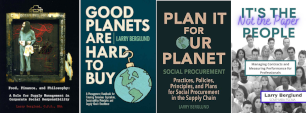Much is being said about having a diverse work force. The message here is that a diverse set of skills, perspectives, and backgrounds, invites a broader view on any issues being discussed. This often leads to innovation, breaking out of complacency and finding options leading to better solutions to old problems. All good. Studies continue to show that organizations with greater ethnic and gender diversity outperform their competitors.
Where there is an affinity for values between the staff and the organization, the diversity supports a positive milieu. People know that their ideas will be weighed, even if their ideas are not adopted. They know that mutual trust and respect allow them to be creative and contribute beyond their pay grade. Their decisions will favour the whole rather than the few. Employees who feel they are being heard in the workplace typically put 4 times the effort into their work.
Employee engagement is one of the key outcomes of a positive workplace. Naz Beheshti, writing in ForbesWomen, states that engaged employees contribute 21% greater profitability. Its been shown that the 34% of engaged employees have 40% less absenteeism and 60% less turnover. Conversely, actively disengaged employees, those who have poor experiences in the work place, comprise 16% of the workforce – which is at an historic low, according to a 2018 Gallup survey. The other 50% of employees are not engaged – not cognitively and emotionally connected to their employer’s interests! This latter statement is quite astounding. This should cause leadership in organizations to reflect on building a culture which supports engagement, with diversity being one of the attributes to forming relationships.
The key to diversity bringing advantages to the organization is to have a common agreement on what value means. If people within an organization do not have a common concept of value, their diversity can lead to incongruence or passive engagement. As individuals, they will interpret value as they personally define it. As an example, is spending focused on the lowest cost or is it on the best value? Are profits to be realized by using any type of tactics? What would best value mean in your organization?
Procurement practices need to ensure that best value is the organizational view and not simply based on out-of-pocket savings. Without a common understanding of what value is, we invite bias in decision-making. Staff may choose to not buy products from a company because of a negative headline or internet story – regardless of what may actually have occurred. We lose the potential synergy found in diversity when we haven’t clearly defined value. The divergence of opinion on what value means, detracts from the collective actions.
Diversity in itself, is insufficient to drive values. The culture of the organization will need to demonstrate why diversity is important to its success in the future. Why does it matter that women’s roles in senior management increase as a % of employees? Why does it matter that LGBTQs staff are not being discriminated against? Why does it matter that ethical business practices be fair and transparent? Diversity in an organization is more effective where values are aligned across the workplace. 100% alignment would be nice but not realistic. Based on the statistics stated earlier, a target of 50% would be a significant achievement in employee engagement.
An organizational culture is affected by many external and internal factors and events. The role of the CEO or CAO is to ensure the values being expressed and corporate behaviour resonates with customers and stakeholders. The conduct of the leadership within the organization should consistently reflect the value or mission statement being espoused. We refer to this as the “video needs to match the audio.” Where an unacceptable behaviour, in the eyes of the customers or shareholders, is not congruent with the leadership message, there is often a disconnect by employees as well. The disengaged continue to be just that.
We see how SNC Lavalin, in light of its previous corporate missteps involving bribery, has been forced to change its leadership. SNC must renew its commitment to ethical values in its business practices. SNC’s shareholders and the market have spoken. The Canadian engineering company is exiting the lump-sum turnkey (LSTK) market which SNC identified as the root of its poor financial performance. This has resulted in a ~$1.9 B goodwill impairment charge and intangible assets impairment charge, as reported in their July 2019 press release. Values matter. Behaviours matter. Rogue practices cannot be tolerated – no matter the intentions. Organizational culture is shaped by social values and business practices. While SNC embraces diversity in its workplace, a few individuals compromised their values and principles in favour of their self-serving interests.
Workplace diversity is one of inclusivity and the benefits for this have been widely acknowledged. The ethical conduct of individuals also speaks to the corporate culture and tolerance. If employees, clients, or customers see the leadership not being respectful; or is only meeting its legal obligations; or is not “doing the right thing” – it sends a mixed signal which everyone hears. Senior leadership behaviour has a large impact on employee engagement. It’s the responsibility of the leadership to support the values in their actions with all stakeholders. A divergence in the opinion as to what the corporate values represent, can come at a tremendous cost to the organization and to the individual. This is particularly true at a time when skilled and disciplined procurement and supply staff are in short supply.
July 2019

